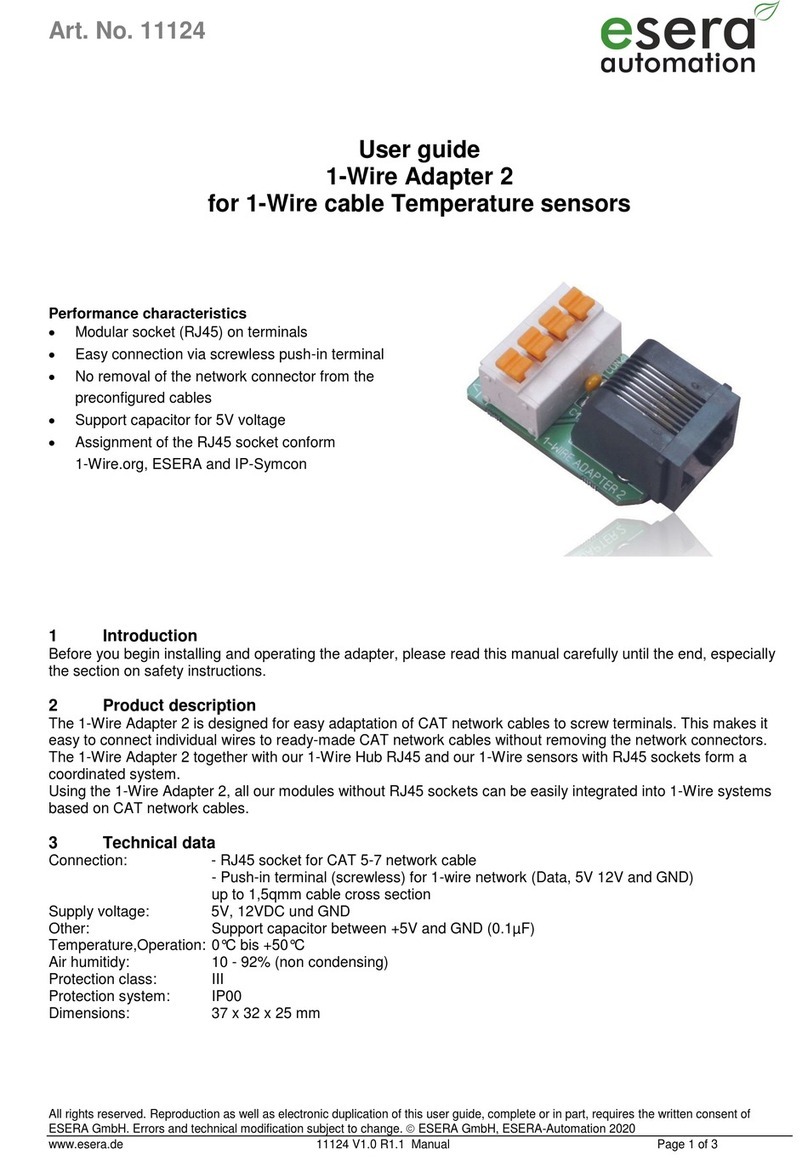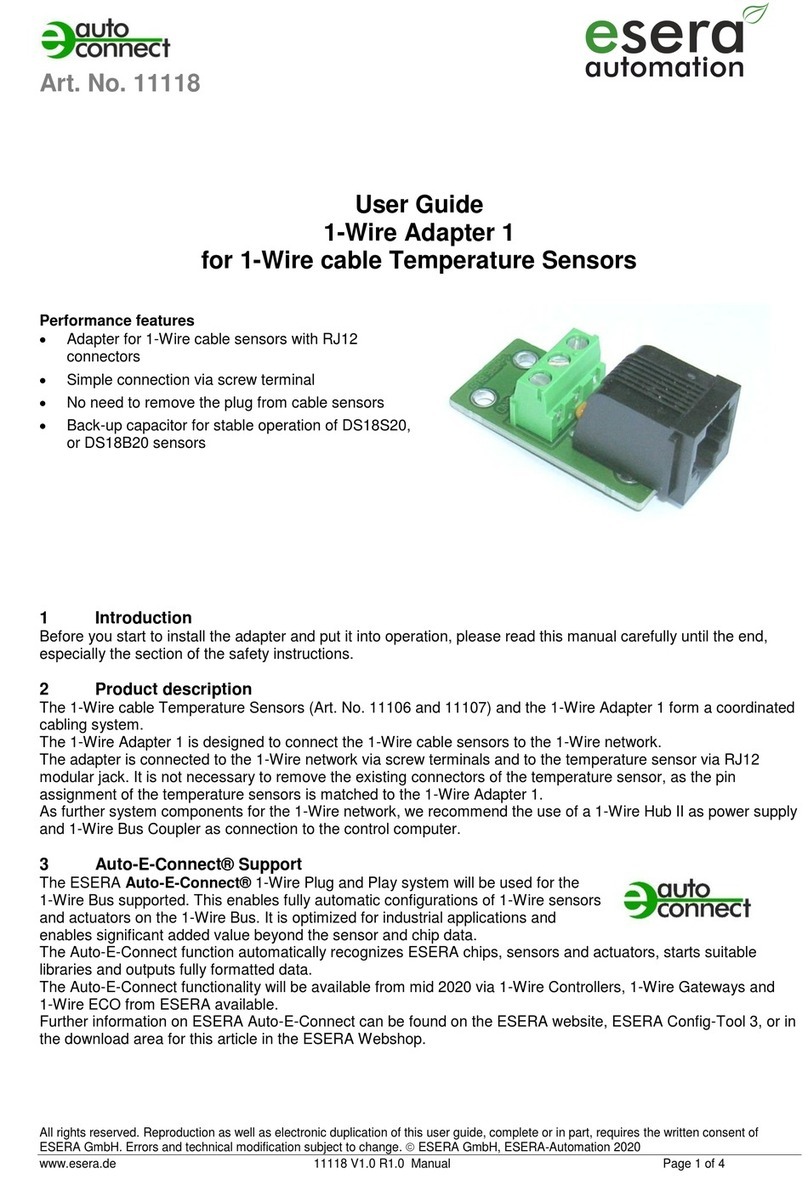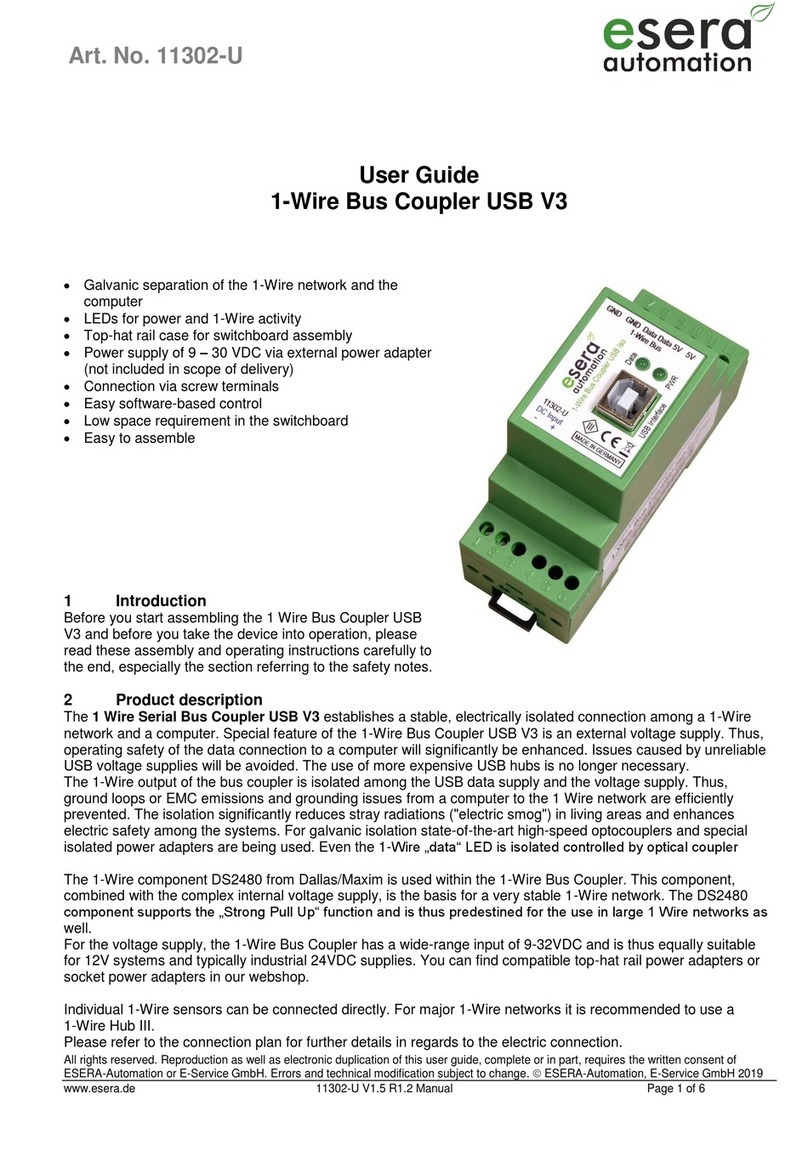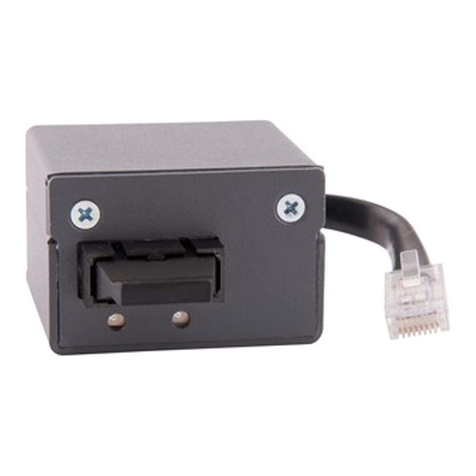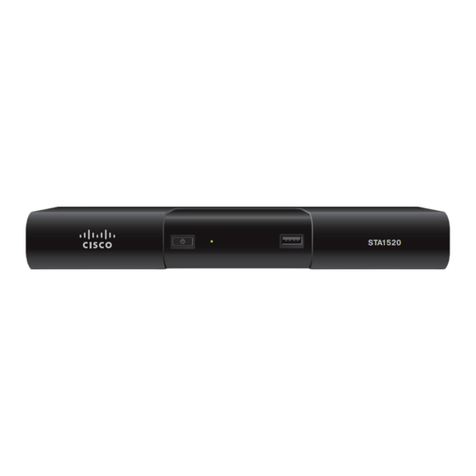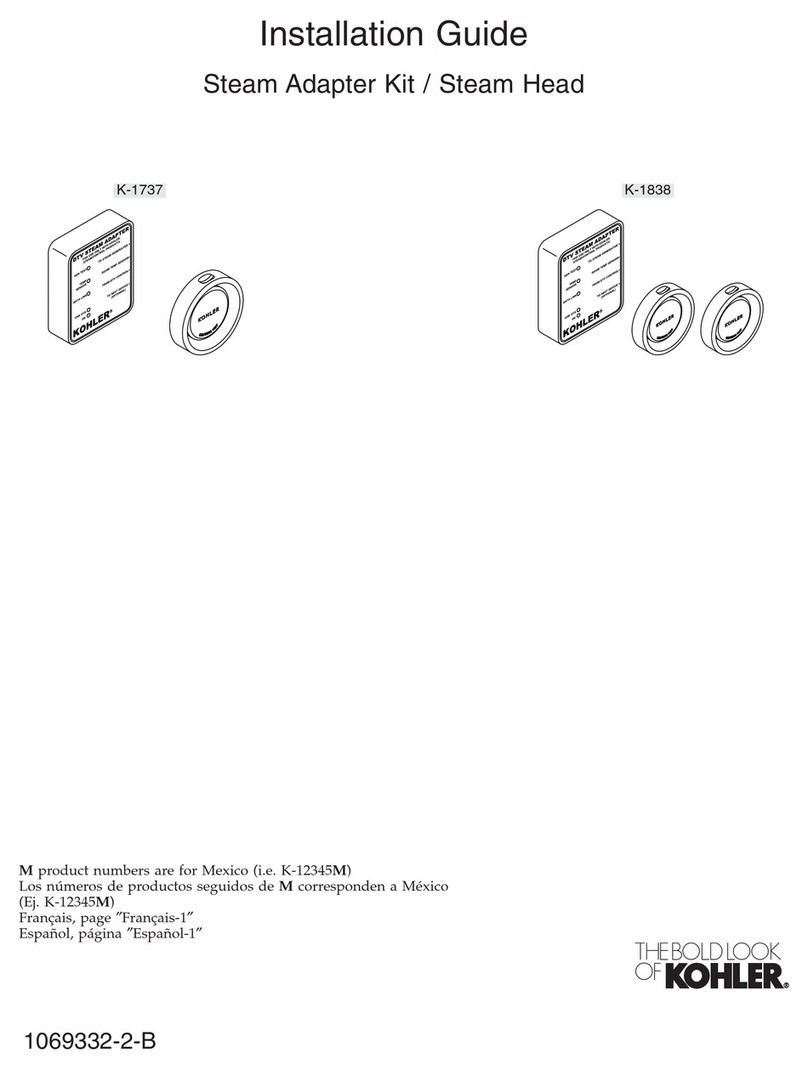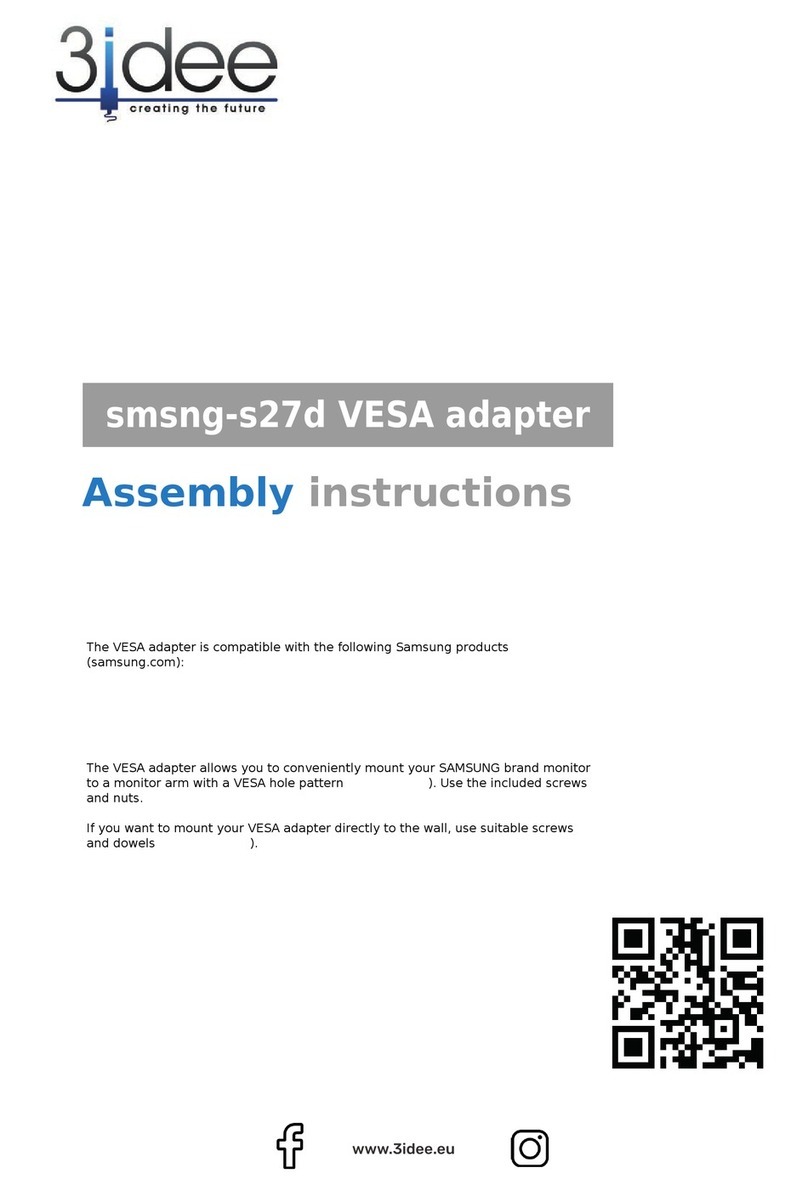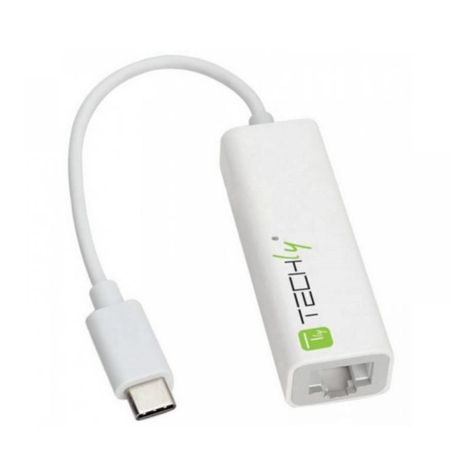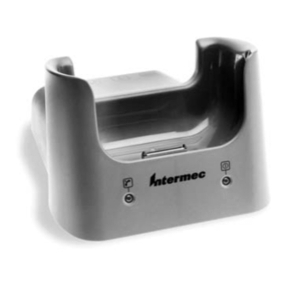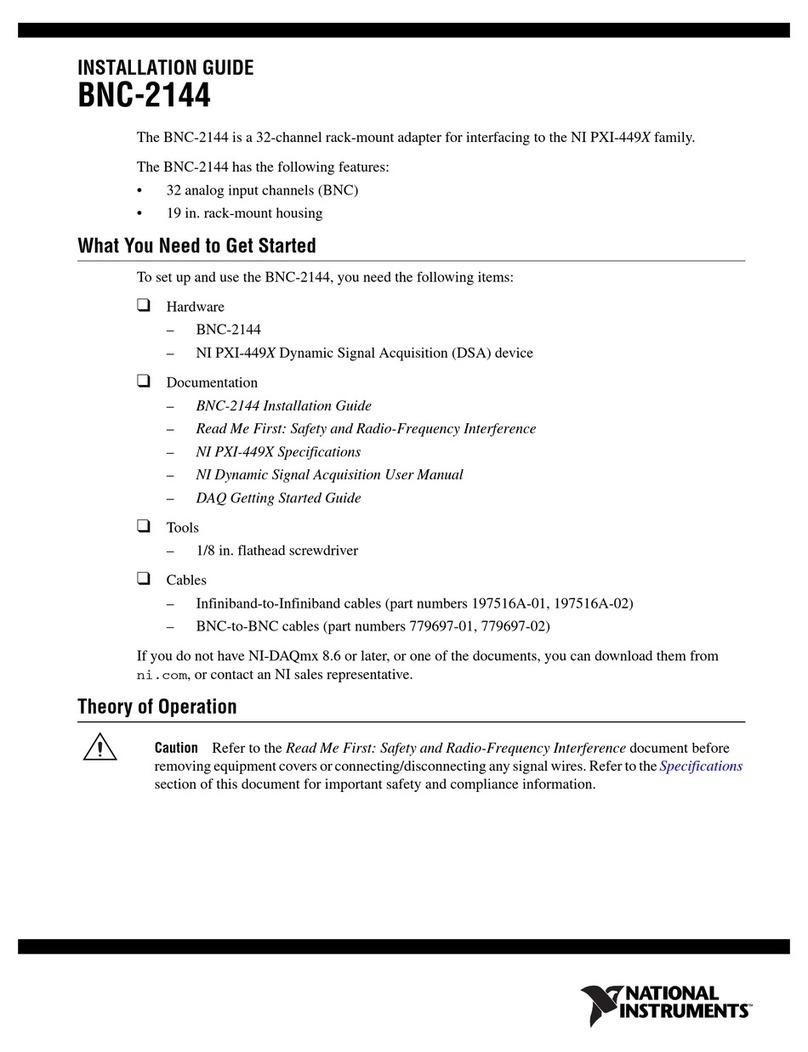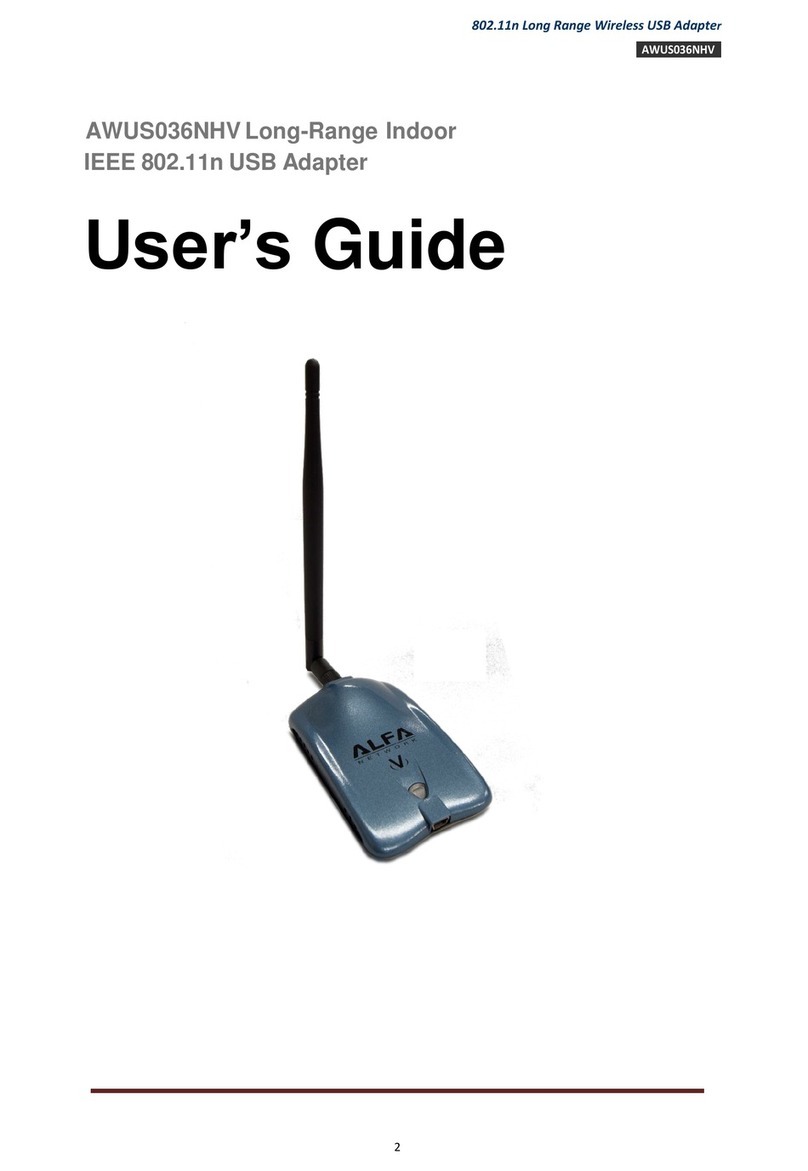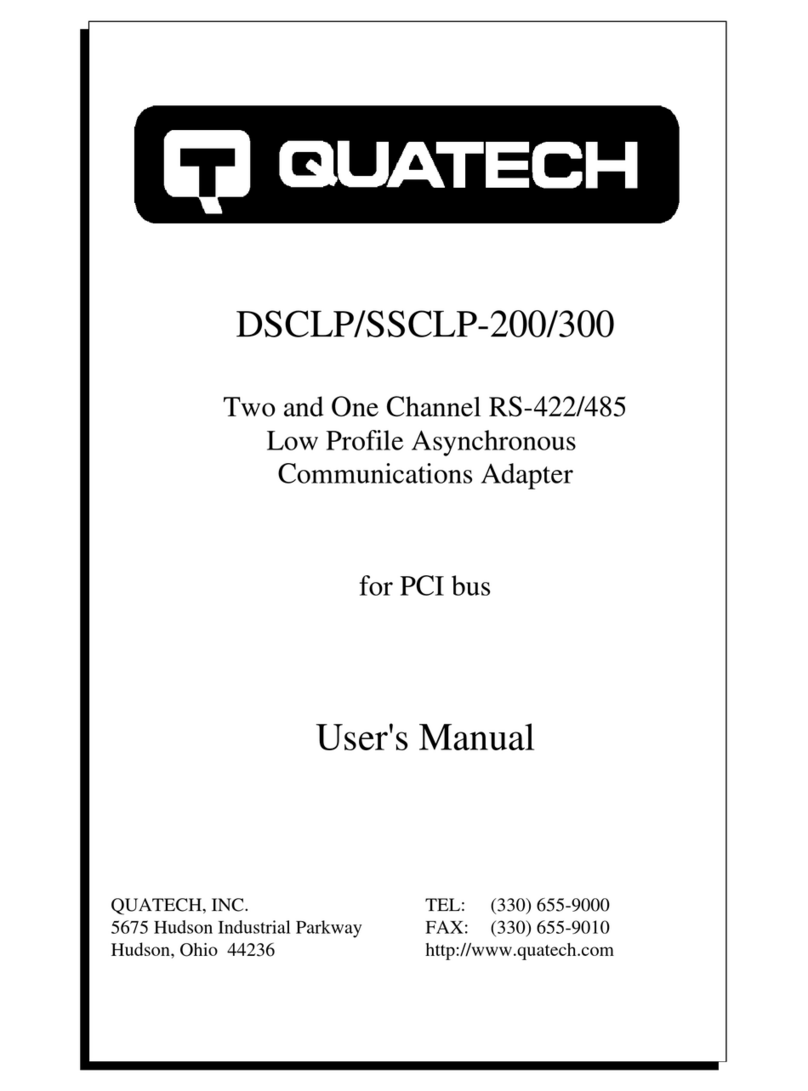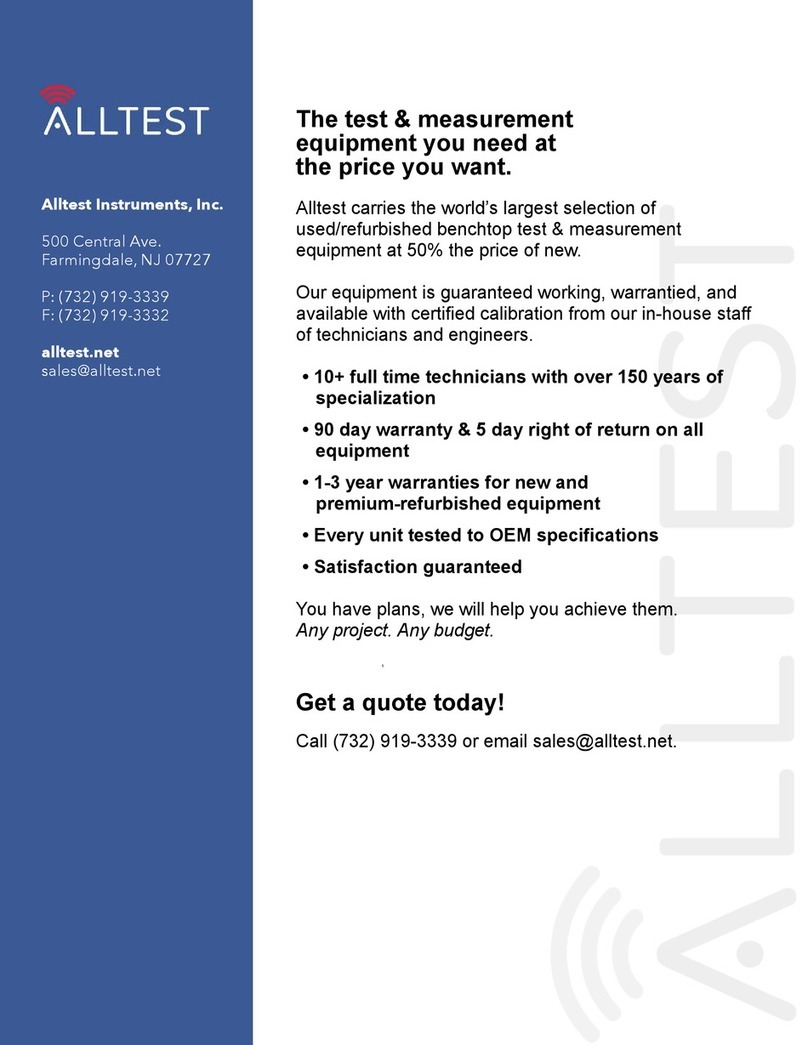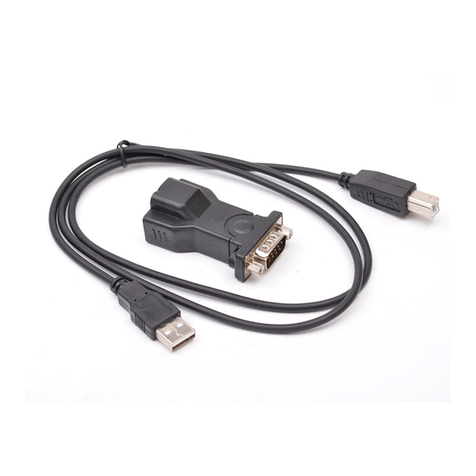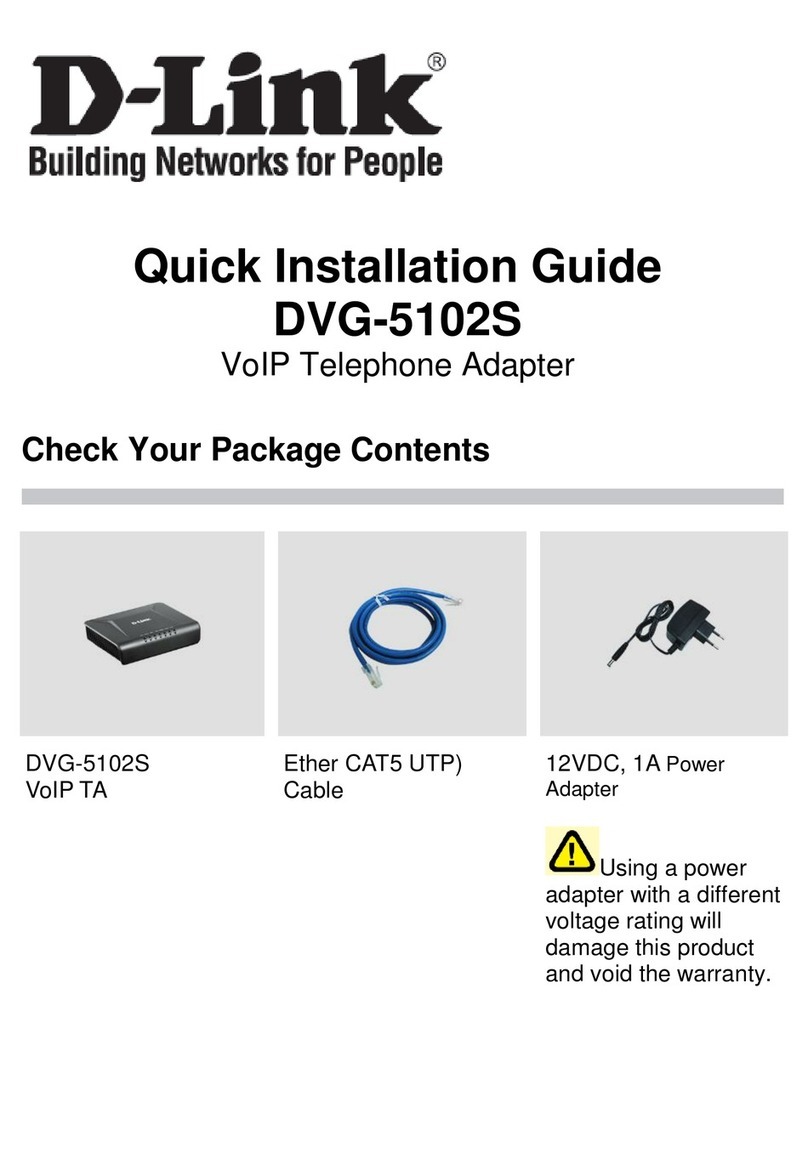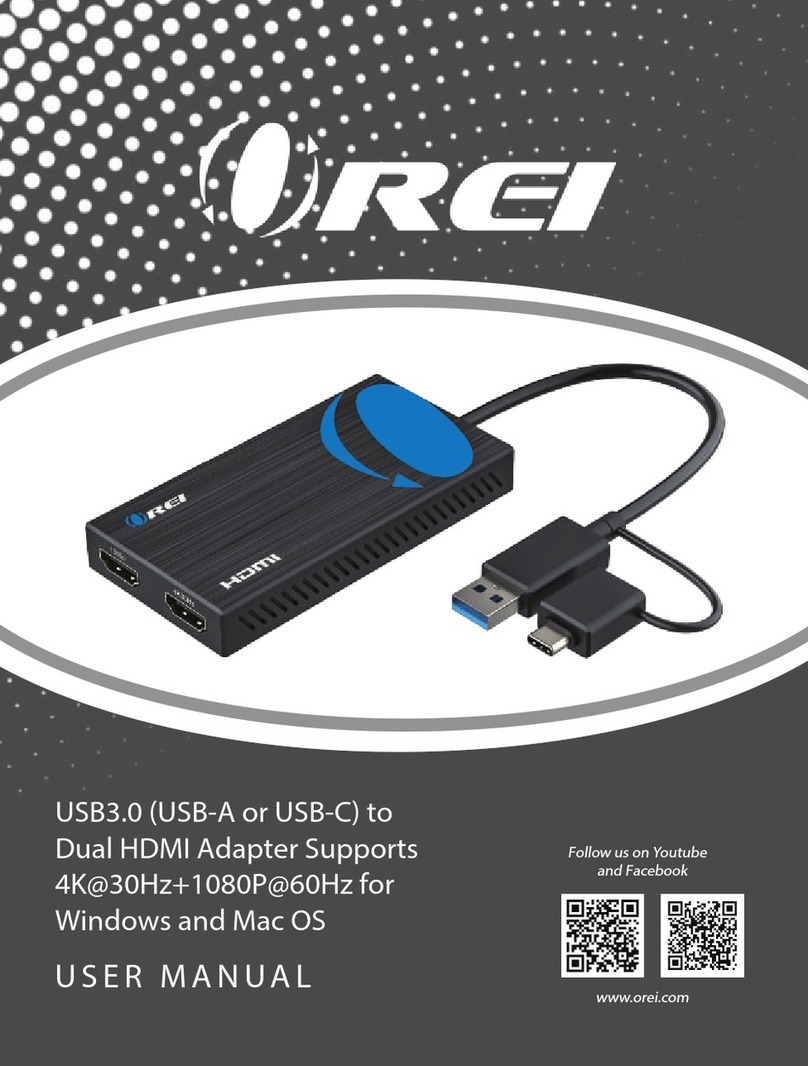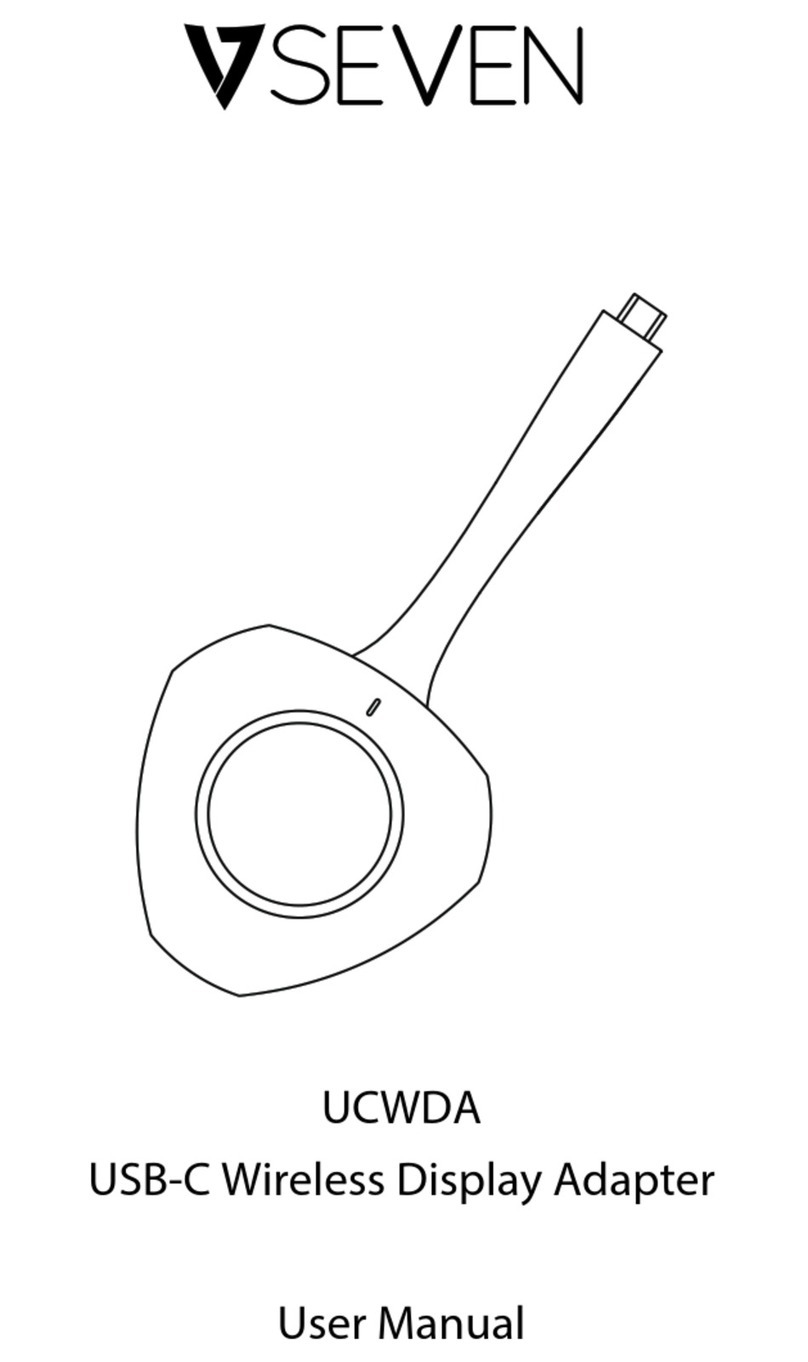esera automation 11308 User manual

All rights reserved. Reproduction as well as electronic duplication of this user guide, complete or in part, requires the written consent of
ESERA-Automation or E-Service GmbH. Errors and technical modification subject to change.©ESERA-Automation, E-Service GmbH 2019
www.esera.de 11308 V1.0 R1.0 Manual Page 1 of 5
Art. No. 11308
User Guide
1-Wire Bus Coupler Ethernet
Configuration:
•Ethernet connection for 1-Wire bus
•Galvanic separation of 1-Wire network
and computer
•LED display for power, 1-Wire activity, link
and data transfer
•Top-hat rail case for the assembly of the switchboard
•Integrated power adapter for the voltage supply
of the 1-Wire bus
•Wide voltage supply range
•Connection for 1-Wire bus via screw terminals
•Easy software-based integration as COM port
•Low space requirement in the switchboard
•Easy to assemble
1 Introduction
Before you start assembling the 1 Wire Bus Coupler Ethernet and before you take the device into operation,
please read these assembly and operating instructions carefully to the end, especially the section referring to the
safety notes.
2 Product description
The 1-Wire Bus Coupler Ethernet enables a stable and electrically isolated connection of the 1-Wire network to a
PC or minicomputer (e.g. Raspberry Pi). Ground loops or fault transmissions between 1-Wire network and
computer are prevented by the use of the 1-Wire bus coupler Ethernet.
Within the 1-Wire Bus Coupler, the serial to 1-Wire module DS2480 from Dallas / Maxim is used. This module - in
combination with the complex internal power supply and the Ethernet module - are the basis for a very stable 1-
Wire network.
The 1-wire master within the 1-wire bus coupler Ethernet (DS2480 module) supports the "Strong Pull Up" function
and is therefore particularly suitable for the operation of large 1-wire networks.
To configure the Ethernet interface, a suitable program "Config Tool" is available via the article download. The
"Config Tool" is part of the "Software package", which you will find in the article Download.
On computer side, the 1-Wire bus coupler is connected via a "Virtual Serial Port" (VSP). The "VSP_INSTALLER"
tool is available for configuring the VSP. Both programs are available for download in our webshop.
On software side, a serial interface (COM port) is available for integration into your application after installation of
the VSP.
An external power supply is required to operate the 1-wire Bus Coupler Ethernet module. The outputs of the
module (5V and 1-wire bus) are short-circuit-proof and galvanically connected to the supply voltage input. For
details on the connection, please refer to the “connection plan".
The 1-Wire Bus Coupler has LED displays for "Power" and "1-Wire activity", "Ethernet Link" and "Traffic".

All rights reserved. Reproduction as well as electronic duplication of this user guide, complete or in part, requires the written consent of
ESERA-Automation or E-Service GmbH. Errors and technical modification subject to change.©ESERA-Automation, E-Service GmbH 2019
www.esera.de 11308 V1.0 R1.0 Manual Page 2 of 5
3 Technical data
Ethernet:
Interface: TCP/IP, UDP (each as server or client)
Ethernet: 10/100 Mbps Ethernet Interface (RJ45)
Auto Negotiation (Full-duplex and Half-duplex)
Auto MDI/MDIX
Ethernet Interface: Ethernet to Serial
Software Interface: Virtual Serial Port (VSP)
Operating systems: VSP for Windows Vista, Windows 7, Windows 10
Windows Server 2003 to 2016, all Windows 64-bit platforms
Software: Support for fixed IP-Addresses or DHCP
Support for DNS
Software for Ethernet, Serial and VSP Configuration
1-Wire Interface:
1-Wire Master: DS2480B (bus-master)
Interface: 1-Wire Bus, 5V, Data (5V signal level) and GND / load
Protection circuit: ESD protection and reverse voltage protection
Connection: Screw terminals (up to 2,5 qmm wire cross section)
Output voltage: 5V (+/-10%), nominally 200mA, max. 300mA
Isolation: Galvanic separation between Ethernet and 1-Wire interface
Ambient conditions:
Temperature, operation: 0°C up to +50°C
Air humidity: 10 - 92% (non-condensing)
Dimensions: 35 x 90 x 70mm (BxHxD)
Protection class: III
Insulation class: IP20
Voltage supply:
Input voltage: 8 - 30VDC
Power consumption typically 250mA (without load at the 5V output)
Note: For the supply of the 1-Wire network, we recommend the use of one of our 1-Wire Hub Modules.
4 Conformity
EN 50090-2-2,
EN 61000-4-2, ESD
EN 61000-4-3, HF
EN 61000-4-4, Burst
EN 61000-4-5, Surge
EN 61000-6-1, Fault-free operation
EN 61000-6-3, Stray radiations
RoHS
5 LED Display
The module has different LED displays. The function of the displays is explained in the following.
6 Software
In the article download section in our webshop, a software package, including installation instructions, is ready for
download. The bus coupler operated via 1-Wire commands for the DS2480 component.
Display
Label
Function
LED Green
Power
Display for 5V output voltage
LED Green
Active
•Flashes in the case of 1-Wire activity.
•Permanently flashes in the case of the 1-Wire Data Line short-
circuit.

All rights reserved. Reproduction as well as electronic duplication of this user guide, complete or in part, requires the written consent of
ESERA-Automation or E-Service GmbH. Errors and technical modification subject to change.©ESERA-Automation, E-Service GmbH 2019
www.esera.de 11308 V1.0 R1.0 Manual Page 3 of 5
Art. No. 11308
Windows:
For Windows, a bus coupler configuration program (Config-Tool) and a software for the creation of a virtual serial
port (VSP-Tool) are available.
Linux:
At the moment we have no available configuration software, respectively connection for Linux.
We would like to refer to the „remserial“ project: http://lpccomp.bc.ca/remserial/.
7 Update Ethernet interface (Firmware for interface)
No firmware update of the Ethernet interface should be necessary during the entire lifetime.
If you do, please use the "Config Tool 1" of the software package.
Before starting the update, close all applications and services that could write or read data to the bus coupler!
Malfunctions of the 1-Wire bus coupler due to programming or an update are not subject to the warranty
conditions.
Should an update nevertheless be necessary, we will be pleased to carry out an update for you as a service. We
are also happy to carry out the programming of the network interface for you. In this case, please return the
device back to us for further handling.
8 Connection plan
Module top side
(1-Wire Bus)
7 + 8 = 1-Wire GND/load
9 + 10 = 1-Wire data
11+12 = + 5V output
Modul bottom side
(voltage supply)
1 = Minus input 9-30V
2 = Plus input 9-30V
3 - 6 = not in use
9 Operating conditions
The operation of the assembly group can take place only on condition of observing the required voltage and the
ambient conditions. The operating position of the device is irrelevant. The device is meant to be used in dry and
dust-free areas.
Should condensed water build up, an acclimatization period of at least 2 hours must pass.
Assembly groups and components do not belong into the hands of children!
The building group can be operated only under the supervision of an electrically skilled person.
In industrial facilities, the accident prevention regulations of the federation of industrial professional associations
for electrical installations and equipments must be observed.
Do not operate the assembly group in an environment with inflammable gases, vapours or dusts or in an
environment where such gases, vapours or dusts may be found.

All rights reserved. Reproduction as well as electronic duplication of this user guide, complete or in part, requires the written consent of
ESERA-Automation or E-Service GmbH. Errors and technical modification subject to change.©ESERA-Automation, E-Service GmbH 2019
www.esera.de 11308 V1.0 R1.0 Manual Page 4 of 5
10 Assembly
The module may only be operated at the specified voltages and ambient conditions. The device is
intended for installation inside a control cabinet as a stationary device.
11 Disposal note
Do not dispose of the device within the household waste!
According to the directive concerning old electrical and electronic appliances, electronic devices
must be disposed of via the collecting points for old electronic
appliances!
12 Safety instructions
When using products that come into contact with electrical voltage, the valid VDE regulations must be observed, especially
VDE 0100, VDE 0550/0551, VDE 0700, VDE 0711 and VDE 0860
•All final or wiring work must be carried out with the power turned off.
•Before opening the device, always unplug or make sure that the unit is disconnected from the mains.
•Components, modules or devices may only be put into service if they are mounted in a contact proof housing.
During installation they must not have power applied.
•Tools may only be used on devices, components or assemblies when it is certain that the devices are
disconnected from the power supply and electrical charges stored in the components inside the device have been
discharged.
•Live cables or wires to which the device or an assembly is connected, must always be tested for insulation faults
or breaks.
•If an error is detected in the supply line, the device must be immediately taken out of operation until the faulty
cable has been replaced.
•When using components or modules it is absolutely necessary to comply with the requirements set out in the
accompanying description specifications for electrical quantities.
•If the available description is not clear to the non-commercial end-user what the applicable electrical
characteristics for a part or assembly are, how to connect an external circuit, which external components or
additional devices can be connected or which values these external components may have, a qualified electrician
must be consulted.
•It must be examined generally before the commissioning of a device, whether this device or module is basically
suitable for the application in which it is to be used.
•In case of doubt, consultation with experts or the manufacturer of the components used is absolutely necessary.
•For operational and connection errors outside of our control, we assume no liability of any kind for any resulting
damage.
•Kits should be returned without their housing when not functional with an exact error description and the
accompanying instructions. Without an error description it is not possible to repair. For time-consuming assembly
or disassembly of cases charges will be invoiced.
•During installation and handling of components which later have mains potential on their parts, the relevant VDE
regulations must be observed.
•Devices that are to be operated at a voltage greater than 35 VDC / 12mA, may only be connected by a qualified
electrician and put into operation.
•Commissioning may only be realized if the circuit is built into a contact proof housing.
•If measurements with an open housing are unavoidable, for safety reasons an isolating transformer must be
installed upstream or a suitable power supply can be used.
•After installing the required tests according to BGV A3 / Betriebssicherheitsverordnung must be performed.
13 Warranty
ESERA-Automation (E-SERVICE GmbH) guarantees that the goods sold at the time of transfer of risk to be free from
material and workmanship defects and have the contractually assured characteristics. The statutory warranty period of two
years begins from date of invoice. The warranty does not extend to the normal operational wear and normal wear and tear.
Customer claims for damages, for example, for non-performance, fault in contracting, breach of secondary contractual
obligations, consequential damages, damages resulting from unauthorized usage and other legal grounds are excluded.
Excepting to this, ESERA-Automation accepts liability for the absence of a guaranteed quality resulting from intent or gross
negligence. Claims made under the Product Liability Act are not affected.
If defects occur for which the ESERA-Automation is responsible, and in the case of replacement goods, the replacement is
faulty, the buyer has the right to have the original purchase price refunded or a reduction of the purchase price. ESERA-
Automation accepts liability neither for the constant and uninterrupted availability of the ESERA-Automation or for technical
or electronic errors in the online offer.

All rights reserved. Reproduction as well as electronic duplication of this user guide, complete or in part, requires the written consent of
ESERA-Automation or E-Service GmbH. Errors and technical modification subject to change.©ESERA-Automation, E-Service GmbH 2019
www.esera.de 11308 V1.0 R1.0 Manual Page 5 of 5
Art. No. 11308
We develop our products further and we reserve the right to make changes and improvements to any of the products
described in this documentation without prior notice. If you need documentation or information about older product
14 Trademarks
All mentioned designations, logos, names and trademarks (including those which are not explicitly marked) are
trademarks, registered trademarks or other copyright or trademarks or titles or legally protected designations of their
respective owners and are hereby expressly recognized as such by us. The mention of these designations, logos, names
and trademarks is made for identification purposes only and does not represent a claim of any kind on the part of ESERA-
Automation, E-Service GmbH on these designations, logos, names and trademarks. Moreover, from their appearance on
ESERA-Automation webpages it cannot be concluded that designations, logos, names and trademarks are free of
commercial property rights.
ESERA is a registered trademark of E-Service GmbH.
15 Contact
ESERA-Automation, E-Service GmbH
Adelindastrasse 20
87600 Kaufbeuren
GERMANY
Tel.: +49 8341 999 80-0
Fax: +49 8341 999 80-10
www.esera.de
WEEE-Number: DE30249510
Table of contents
Other esera automation Adapter manuals
